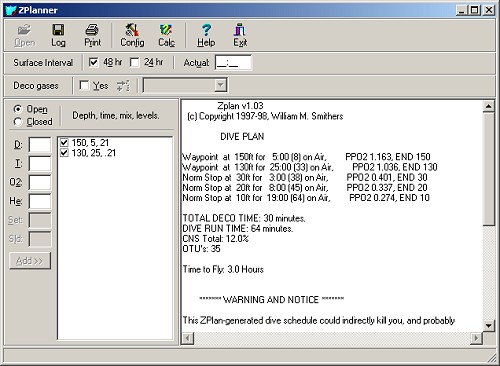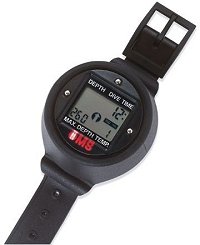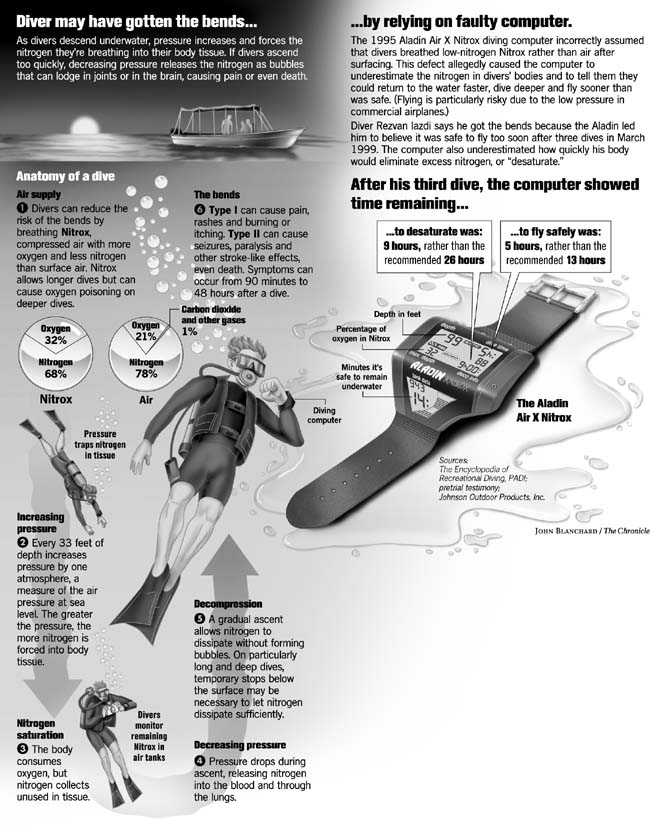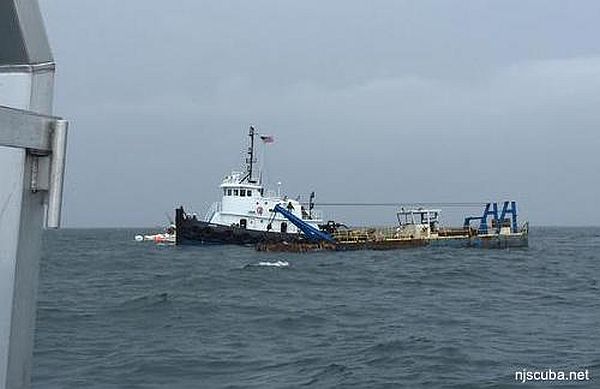Dive Planning Software
2016 Update
Well, computers, you can bet that everything has changed here.

There are a number of computer software packages available that allow you to simulate different dive profiles and create custom decompression tables without actually going in the water. Most of them have graphical interfaces, and allow you to vary not only the dive profile, but gas mixes, decompression mixes, decompression stops, algorithm, conservatism, and many other factors. Software like this is a staple in the technical diving field but is also useful to the recreational diver. Here are a couple, with links:
There are a number of things I would say about dive planning software in general:
- Fancy idiosyncratic graphical interfaces are not helpful.
- Options are not as important as accuracy and correctness. Many options in these programs are silly or simply imaginary.
- The more options and fancier the interface, the more likely the underlying calculations are flawed.

Screenshot of the now-defunct Abyss. This was the prettiest of all the deco programs, just look at the 3-D compartment graph at the lower-left. But it sometimes generated schedules that were obviously and impossibly wrong, and all the graphics in the world won't compensate for that. Thankfully, Abyss is no longer available.

Screenshot of Z-Planner ( Windows interface for ZPlan.) Old, crude, and not pretty at all, and also not terribly accurate. Fortunately, most of its errors pile up on the safe side. Zplan always had a reputation for "getting you out of the water fast" - not necessarily a good thing if it is wrong. But it is easy to use!
I have tried most of the programs in the list above. For the most part, they all generate reasonable schedules, for the spot checking I have done. I haven't run them enough to actually trigger a notable error, but I'm sure they have them. I find that they all have overdone, needlessly difficult interfaces. When I see a fancy graphical interface, I figure the programmer probably spent most of his time on that, and not enough time actually testing his algorithm. Experience has borne this out.
I finally got fed up and wrote my own program. It turns out to be fiendishly difficult to calculate predictive multi-stage decompression profiles. While other programmers made nice graphics, I ran hundreds of test cases, and compared them to real-world decompression schedules, and chased down bugs and funny 'corners' that I had never imagined.
That's great, but what is it good for ?

With dive planning software, you can simulate the dive or dives you plan to do, with all the particulars:
- depths & times
- bottom gas(es)
- deco gas(es)
- temperature, workload, other conditions
After cross-checking the results with Navy tables or another independent source, you can then copy down the decompression schedule on a slate, and do your dives following your planned schedule using a simple and reliable bottom-timer / depth gauge ( or two ) as shown at right. I always generate a number of alternative schedules and take those with me as well, such as longer and shorter bottom times, and different decompression mixes ( should I lose or have to abandon my deco gas. )
This sort of rigorous and deliberate planning and conscious manual execution is much better than simply trusting your whiz-bang super-tek gas-switching decompression dive computer to keep you alive. If you need a computer to remind you when and where to do a hang or switch mixes, then you shouldn't be doing what you are doing. Again, this is not just my opinion, but that of leading technical divers in the Northeast ( of whom I do not count myself among - the majority of my diving is recreational-level no-decompression or minimal decompression. )
These few words here should not be considered even the beginning of an introduction to technical and/or decompression diving. If you have "tek" aspirations, I suggest that you work up to it slowly, with as much practical training and real-world experience as you can get. Doing a few Trimix certification dives in a quarry somewhere does not qualify you to go to the Andrea Doria. Honestly assess your own limits and capabilities, and don't think that having a lot of shiny new gear and a stack of "C-cards" is what is going to keep you alive when the shit hits the fan. Too many people get sold a giant set of doubles and the newest ( very expensive ) "tek" dive computer, get in literally way over their heads, and end up dead ( and I haven't even gotten to the subject of rebreathers yet. )
Here's something crazy:
One weekend of diving, on the second day, after a very ordinary 70 ft no-decompression dive, my computer killed me! On a dive I had done so many times I could do it with just my tank pressure gauge, the dive computer racked up several hours of decompression! ( which I blew off. ) When I got home, still very much alive and feeling fine, I plugged the same two days of diving into Abyss, and it killed me too! Not only did the two have the same algorithm, but they also had the same flaw!
I still use the dive computer as a backup, but I lost all faith in Abyss. That's when I wrote my own decompression program, which is far better than anything I have seen, although not as pretty. As best as I can tell, the problem was that neither computation took into account the 18 hours of surface interval between the two days of diving. You can guess the first profile I ran in my program when it was finished, and it came up with the right answer.
While air and Nitrox computers for recreational diving as described elsewhere have proven to be safe, reliable, and easy to use, the same cannot be said for "technical" computers, designed for mixed-gas decompression diving. Many of these are riddled with dangerous flaws, and many more no doubt have flaws that are yet to be uncovered. Here is just one horror story.


